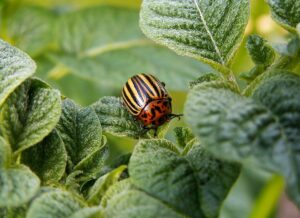Pests are unwelcome guests which can cause damage to your home and possess severe health issues. From chewing through fabrics to leaving their dropping around your home, these guests can wreak havoc on your property.
However, getting rid of pests can be challenging, but it is not impossible. In this article, we’ll help you explore some of the best ways to keep pests at bay and maintain the overall aesthetics of your home. So, let’s get started.
How Do Pests Enter Your Home?

Before we dive into discussing pest infestation, let’s first discuss how pests enter your home.
1. Through Cracks and Gaps
One of the easiest ways for pests to enter your home is through cracks and gaps. If you’ve cracks in floors, ceilings, and walls, then it is an open invitation for pests to enter your property.
Once they are inside, these unwanted guests can chow down on your fabrics, leaving holes that look like they were created by a miniature sewing machine. They can also leave droppings and urine, which can be difficult to remove and can cause unpleasant odors.
2. Through Your Pets
No matter how much you love and adore your four-legged friend, they are one of the culprits who welcome these unwanted guests to your home. Fleas, ticks, and mites are just a few examples that can ride on your furry friend.
And while your pets may not mind the extra company, these pests can wreak havoc on your decor. Fleas can cause unsightly stains on carpets, while ticks can carry diseases that can affect both pets and humans. Mites can leave skin irritation and allergies, as well as chew through fabrics and carpets.
3. Through Open Doors And Windows
Who doesn’t love the fresh and natural air coming inside from the windows? None maybe. While you’re enjoying the natural air, at the same time, you’re also inviting unwanted guests into your home like mosquitoes and fleas.
These guests enter your home through open windows and doors and leave unsightly stains on your walls and ceilings. They can also carry diseases, such as the West Nile virus and Zika virus, which can be harmful to humans.
4. Through Food Sources
Pests are like those annoying neighbors who peep into your home when you’re cooking something delicious. They’re attracted to food sources, such as crumbs, spills, and garbage. And if you’re not careful, they’ll make themselves at home in your pantry, leaving a trail of destruction behind.
Mice and rats are the most common pests which get attracted to food sources. They chew through containers and bags to get to the food, leaving unsightly messes and droppings behind. Also, cockroaches can infest your home if you leave food out, and can quickly multiply if not properly controlled.
5. Through Secondhand Items
While you’re saving a lot of money on buying second-hand items from someone, you’re also inviting some unwanted guests into your home. Some items like furniture, books, and clothing can help pests invade your home. For example, bed bugs can ride on secondhand furniture and quickly infest your home.
6. Through Plants And Soil
If you’re a nature lover, you love to add some beautiful plants and flowers to your home. While adding greenery in your home is great, sadly, they bring unwanted guests into your home, such as gnats, spider mites, mealybugs, etc.
And let’s not forget about the soil – it’s like a hotel for ants, termites, and roaches. These pests can quickly infest your home if not properly controlled, leaving you with a decorating nightmare.
Tips To Keep Pests at Bay without Compromising Your Decor
So now you’ve got an idea of how these unwanted guests invade your home, let’s discuss how to prevent them from entering your property. So, let’s begin:
1. Keep a Clean Home
The first and most important step in pest prevention is to keep your home clean. Pests are attracted to food, moisture, and clutter, so it is essential to keep your home free of crumbs, spills, and standing water.
Regularly clean and sanitize your kitchen, bathroom, and other areas where pests are likely to breed. Make sure to wipe down countertops, sweep floors, and dispose of trash regularly.
2. Hire a Pest Control Professional
If you are struggling with a pest infestation, it is best to hire a pest control professional. They can identify the type of pest and the extent of the infestation, and provide a tailored solution to eradicate the pests.
Most homeowners prefer to opt for DIY pest infestation. Know that DIY tips and tricks can help you get rid of pests, but the chances are higher that they will come back. So, to get a permanent solution for this problem, it is wise to seek exterminator solutions and ask for references and certifications.
The professionals are equipped with all the tools and technologies that will prevent pests from invading your home. Also, they will ensure that your home remains pest-free.
They can also use non-toxic methods to eliminate pests, such as traps, baits, and even essential oils. And if you’re dealing with a more serious infestation, they can use more advanced methods such as fumigation.
3. Seal Cracks and Holes
As you know, pests can easily enter your home through small cracks and holes in walls, windows, and doors. To keep them at bay, it is important to seal these entry points. For example, you can use caulk to seal gaps around windows and doors and fill any cracks or holes in your walls.
You can also consider installing weather stripping to seal gaps between doors and frames. This will not only keep pests out but also help to improve your home’s energy efficiency.
4. Store Food Properly
Pests are attracted to food, so it is important to store food properly. Keep food in airtight containers, and store them in a pantry or cupboard. Make sure to clean up spills and crumbs immediately, and avoid leaving food out for long periods.
Store pet food in sealed containers and clean up any spills or crumbs. This will not only help to prevent pests but also keep your food fresh for longer.
5. Keep Your Garden Tidy
Your garden can be a breeding ground for pests, so it is important to keep it tidy. Remove any fallen leaves or debris, and trim any overgrown plants or bushes. Pests can hide in tall grass and bushes, so keep your lawn mowed and your shrubs trimmed. Make sure to dispose of any garden waste properly, and avoid composting food scraps.
6. Use Natural Pest Control Methods
Chemical pesticides can be harmful to your health and the environment, so it is best to use natural pest control methods. Several natural remedies can help to repel pests, such as essential oils, vinegar, and diatomaceous earth. You can also use traps and baits to catch pests, such as sticky traps for flies and cockroaches or mouse traps for rodents.
7. Keep Your Home Dry
Pests are attracted to moisture, so it is important to keep your home dry. Fix any leaks in your plumbing, and make sure to dry out any damp areas immediately. Use a dehumidifier in areas with high humidity, such as basements and bathrooms. Make sure to clean gutters and downspouts regularly, and ensure that water drains away from your home’s foundation.
8. Use Screens and Mesh
Using screens and mesh can help to keep pests out of your home. Install screens on your windows and doors to prevent flies, mosquitoes, and other insects from entering your home.
For example, you can use mesh to cover any vents or openings in your home’s exterior, such as attic vents and crawl space openings. This will not only help to prevent pests but also improve your home’s ventilation.
9. Keep Your Garbage Bin Clean
Garbage bins can attract pests, such as rodents and flies, so it is important to keep them clean. Use a bin with a tight-fitting lid, and make sure to empty it regularly.
Rinse out the bin with soap and water, and disinfect it with a bleach solution to kill any bacteria or odors. Also, avoid leaving garbage bags outside for long periods, as this can attract pests and animals.
10. Get Rid of Standing Water
Standing water acts as a breeding ground for mosquitoes. Thus, to avoid mosquitoes from entering your property, make sure to eliminate any areas where water can collect around your home.
This includes checking for leaky pipes, yards, fixing any outdoor faucets, and emptying any containers that could hold water, such as flower pots and bird baths.
11. Use Essential Oils
Essential oils are a great natural way to keep pests at bay. Peppermint oil is particularly effective at repelling spiders and ants, while lavender oil is great for deterring moths and mosquitoes.
Just add a few drops of your chosen oil to a spray bottle with water and spritz it around your home.
Summing Up
Keeping a stylish home free of pests requires a combination of preventive measures and natural pest control methods.
While pests may be a nuisance, they don’t have to ruin your home’s interior. With a little caution and following the right practices, you can ensure that your home remains pest-free, healthy, and stylish./



